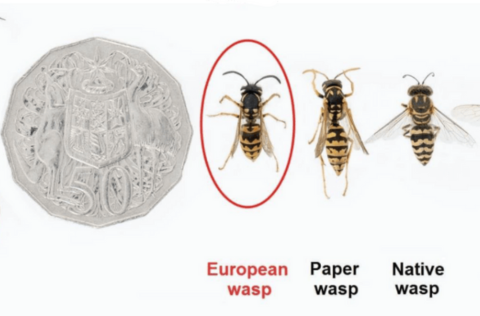Wasps

Did you know wasps are a diverse group of insects, with over 12,000 species in Australia alone? Like bees, some wasps are native, and play an important role in the pollination of our environment.
While wasps can be concerning, they are not usually a pest if they are located away from pedestrian areas.
It is important to have a basic understanding of wasps, particularly European wasps (Vespula germanica), as they are well established within the Murrindindi Shire.
A small percentage of people will experience anaphylaxis from wasp stings. For any life threatening symptoms such as anaphylactic shock immediately call emergency services on 000.
European wasp profile
While European wasps are not aggressive to humans or other animals while undisturbed, they can become aggravated and sting. If a nest is disturbed, the wasps release a chemical to trigger the nests defenses. Unlike a bee, these wasps can sting multiple times.
The European wasp is identifiable by features such as:
- black and yellow body
- yellow legs
- triangular markings on the abdomen
While the European wasp is the same size as a bee (10 - 15 mm), it is less hairy and folds its wings back at rest. Queen European wasps have identical markings and colouring, except are larger.
Council's responsibilities
It is Council's responsibility to manage nests on municipal (Council-managed) land. If you see a nest of concern on Council land, we encourage you to contact us on (03) 5772 0333 so we can arrange an assessment and removal if necessary.
Nests found on Crown Land should be referred to the relevant land owner/land manager and can be reported to Agriculture Victoria.
Landowner responsibilities
Under Clause 10.2 of Council's Community Local Law 2020(PDF, 907KB), landowners are required to remove and/or destroy European wasp nests on private land. If required, Council can give written direction for this to occur.
Depending on severity, may require an at home treatment product or the services of a professional pest controller.
How to make a wasp trap
Found a nest on your property? Watch the video below or download How to make a Queen Wasp Trap(PDF, 428KB) for instructions on how to make a trap. For this project, you will need:
- a bottle
- knife
- apple
- skewer
- tape
Nest treatment
European wasps can only be controlled by finding and destroying the nest.
Please remember, if you are planning on treating a wasp nest yourself:
- always wear loose clothing, fully covering your body, a floppy hat or veil and gloves
- tell someone what you are doing and where you will be
Did you know European wasp nests are:
Locating the nest is the first step in managing an infestation. It may require co-operation and planning with neighbours as wasps are known to scavenge for food up to 500 m from the nest.
To identify the direction of the nest, you can:
- place a food source (i.e. meat or pet food) in a visible location
- observe for wasps collecting the food
- once a wasp is identified, follow the flight path (during early morning or evening is best)
- keep relocating the food sources in the direction of the nest (wasps may be scavenging for food up to 500 m from the nest)
Still having trouble finding the nest? Keep an eye out for:
- places that would provide shelter and structure for a nest
- streams of wasps (particularly entering or leaving holes in the ground)
When treating the nest, it may be helpful to:
- treat the nest at night when wasp activity is low
- cover your torch with red cellophane as insects cannot see red light
- if possible, position the torch some distance from yourself, yet still illuminating the area to be treated
Visit the Department of Health's European wasps - pest control page for more information on identifying, locating and treating European wasp nests.
For further advice on wasp management or to report a nest on Council-managed land, call Council on (03) 5772 0333.